Construction Article and Review of Great Planes "Venus .40" ARF
Trimming & Flying
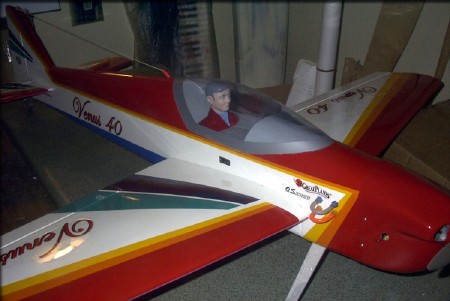
One of the nicest ARFs I've every seen, and at less than $200, a real winner!
I bought this kit myself. No one gave it to me, nor do I have anyone to please with this little review. I simply truly like this kit!
I was careful to get the CG and lateral balance right, before the first flight. I downloaded the updated manual (a PDF document) from the Great Planes web site, to be sure the CG was not updated. The "Venus" balanced on the correct CG with no adjustments needed from me. I was shocked and pleased to find that the plane also balanced laterally, with no weight needed. That's quality!
My configuration was according to the manual, except for these small exceptions:
I substituted the Klett tailwheel assembly.
I included the 1/5th scale Williams Brothers pilot.
Battery and receiver just in front of the servo tray, with fuel tank just in front of that. (more rearward than "stock")
I omitted the wheel pants for the first flights.
That's it! Otherwise, strictly a "by the book" build. In the past, I've considered Great Planes kits to be "overbuilt, (heavy) but sturdy". I see a definite change for the better in the construction of this kit. It's strongly built, but not overbuilt. They're using more modern design concepts, excellent materials, and the quality of the kit right out of the box really is spectacular. I actually felt so strongly about this that I emailed Great Planes and let them hear about it!
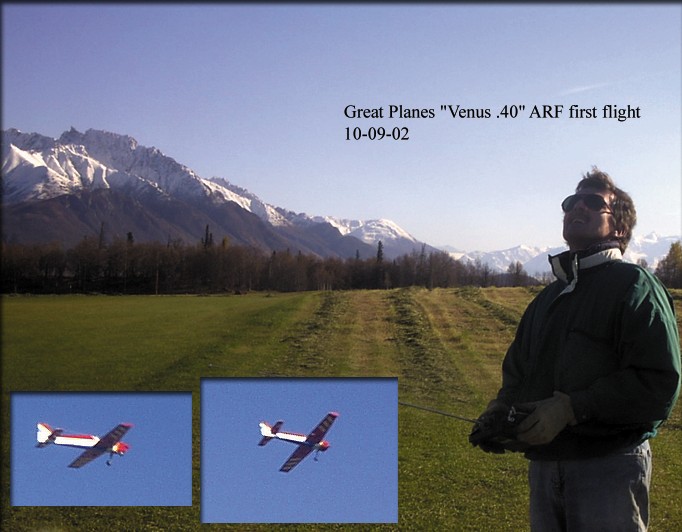
First flights went smoothly with no problems. (except the 20 mph wind and 30 degree temperature)
Right off the building table, the plane needed no trim. How nice is that?! The wind was blowing about 20 mph and gusty. So, I can tell you that the plane flies well, and does smooth aerobatics, but I can't tell you about details. It was just too hard to judge the tracking of the plane in today's wind conditions. Using a OS .46FX and 11-7 APC prop, the "Venus .40" has excellent vertical performance (but not unlimited) and especially nice handling in the knife edge mode. On my first attempt to fly a knife edge pass, the plane simply pulled up into a knife edge loop! It takes very little rudder, and only about half throttle to fly a nice knife edge pass. The plane loses energy well on landing, and has no bad habits I could spot today. The next time I fly it, I'll try and report on it's low speed handling and landing.
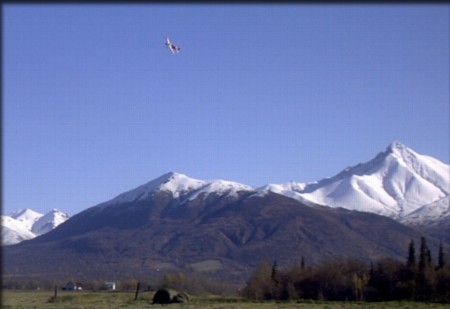
Flying season is too short here, but it sure is beautiful!

Snow's at about 1500 feet now. A few weeks and it'll be on the ground.
A few days after the first flights, we went out again. It was drizzling rain, but dead calm. (Due to the rain, we didn't pull out the camera, so I have no photos of this day's flights....Next time!)
Thanks to the calm, I was able to get a better picture of this model's handling. With the Venus still balanced at the factory CG, all the positive attributes noted on the first flight were confirmed. Rudder response is very close to being "pure yaw", and this not only results in good knife edge flight, but enables some pretty spectacular steep approaches. In a series of touch and goes, I brought the model over the field for a short final, but at an altitude of about 150 feet. Reducing the power to idle, applying full rudder and opposite aileron resulted in a slow knife edge decent that I felt was safe to continue until about 25 feet. I've had some aerobatic planes that didn't like to sideslip, but the Venus is stable.
The Venus snaps and spins when you want it to, but is otherwise very stable. I flew the plane around at a safe altitude, on high-rate, full up elevator. The plane rocked it's wings like crazy, but was so stable that I could fly it in a straight line with no aileron or rudder correction. It's great to discover this at a safe altitude, so you know that if it occurs close to the ground, you won't feed in a lot of correction that could cause the model to stall. I really like this simple design.
I noticed some "hunting" in pitch, when transitioning between slow flight and high-speed flight, but this was easy to correct. For the next flights, I will reduce my low-rate control throws somewhat, (Mine were higher than those suggested in the manual.) and move the CG slightly aft, in an attempt to flatten spins. I'll then post the results here.
Aha! Re-checking the CG showed me that my "Venus" was a bit nose heavy, so I corrected it by moving the battery. (See photo below) We went out and flew again and performance was much better. I'm going through the typical pattern-style trim process, but it's going slowly, since we've only had one calm day out of the 4 days I've flown it. Maybe this weekend...
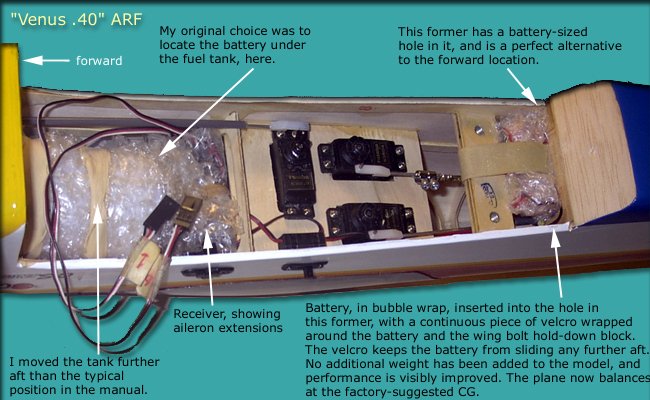
Here's how I fixed the CG without adding any weight.
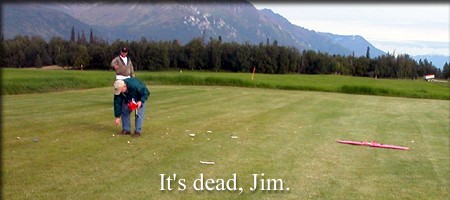
After a year of flying this plane as hard as I'm capable of flying it, I finally paid for it with an impressive crash. Dove down from about 1000 feet, and swooped the runway for a fast pass, about 4 feet off the ground.... Near the end of the runway, contemplating my pull to vertical, I glanced away for a moment at another plane in the air. The photo explains the result.
You have to laugh, sometimes, and this crash was a beauty. The plane was probably going 60 or 70 mph, hit the deck relatively flat, and the "spray" from the debris was really something to see. Radio is fine, but the engine was missing from the pile of confetti-like material that was left... We found the engine about 50 feet out into the tall grass in the photo, making it's total distance from the crash about 100 feet. Wow.
If you're going to crash, might as well make it a good one.
>>> Mike James